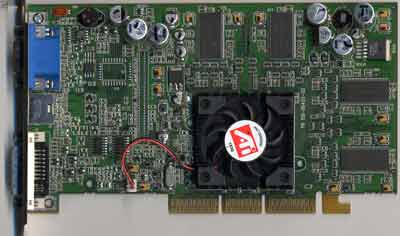
Original Link: https://www.anandtech.com/show/946
ATI Radeon 9000 Pro – The GeForce4 MX Killer
by Anand Lal Shimpi on July 18, 2002 5:00 AM EST- Posted in
- GPUs
It’s easy to lose sight of what’s actually selling in the market when all you hear about are the absolute fastest $400 video cards. A great many of us were more than eager to spend $600 on a speedy Voodoo2 SLI configuration seemingly ages ago, but in the days of 6-month product cycles, it is difficult to justify spending that much money on a graphics card.
Granted, ATI’s other launch today, the R300 based Radeon 9700, is an example of a product worth its $399 price tag; however, we must grant equal if not greater attention to solutions from ATI and NVIDIA that are priced well below that mark.
If you listened to your peers in the community, you would think that the vast majority of graphics cards sold were GeForce4s and no one would even come close to touching a GeForce4 MX. In reality, NVIDIA’s GeForce4 MX line has been selling like hotcakes and although we weren’t happy with NVIDIA’s naming scheme, resellers and OEMs were more than excited about the product.
The reason behind this is simple; it is the sub-$200 market that ships the largest volumes and thus the company that controls this segment commands the vast majority of the add-in card market. The lucrative nature of this sub-$200 market is the reason that ATI can continue to run a successful graphics business even when they don’t have the fastest graphics card on the block. For months the GeForce4 line eclipsed ATI’s Radeon 8500 and Radeon 8500LE yet ATI didn’t worry too much; while it is nice to have technological and performance leadership (it improves brand recognition tremendously), what makes you money is this large and mostly unexciting sub-$200 market.
We can break the sub-$200 market into further divisions, with the sub-$100 segment making up the majority of the add-in card market. That market is definitely uninteresting, as the primary competitors are the Radeon 7000, the GeForce4 MX 420 and even golden oldies such as the TNT2 and Rage 128 (they are still being sold, just not in retail channels).
It is this sub-$200 market that ATI’s latest mainstream chip, the RV250, is designed to go after. You can already tell a lot about the purpose of the chip by its name; the R200 was the Radeon 8500, ATI’s once top of the line part and the addition of the ‘V’ to any of ATI’s codenames dictates a lower-priced, value part. Incrementing the R200 codename by 50 and adding a V leaves you with the impression that in some ways the RV250 is superior to the R200 found in the Radeon 8500, and in some ways it’s worse.
This article is about finding out what’s better and what’s worse, so without further ado, let’s start dissecting the RV250.
The Chip – You did what to the 8500?
When ATI released the Radeon 8500, they revealed a design choice that went against their original beliefs they had when developing the original Radeon. Instead of equipping the R200 core with three texture units per pipeline, the R200 came with two. The reduction was made simply because, the vast majority of the time, the third texture unit went unused; in the case where more than three textures were being used, a second pass was needed to complete the rendering anyways and thus having a third texture unit did not necessary save any rendering passes.
With four pixel rendering pipelines and two texture units per pipeline, it’s difficult to scale down the Radeon 8500’s R200 core to a small enough size that it can be sold in $149 cards. NVIDIA’s solution to this problem was to strip out all of the DirectX 8 programmability out of the GPU, leaving a GeForce2-like NV17 core (a.k.a. GeForce4 MX). ATI has taken a bit of a better approach, and instead of making the RV250 a non-DX8 part, they removed one texture unit from each pixel pipeline.
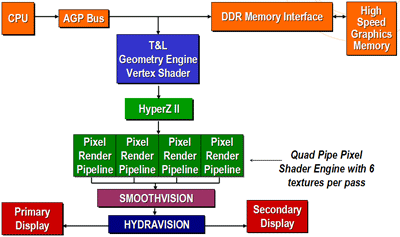
The benefit of the RV250’s architecture is that ATI can reduce die size significantly, while still maintaining competitive performance in games that make extensive use of only one or two textures. The obvious downside to this is that in future games where more textures are used (for example, Unreal Tournament 2003 makes use of four textures in some areas) the RV250 will be slower than the R200.
R200
Core 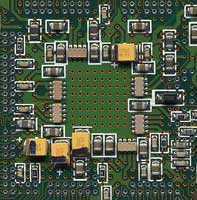 |
RV250
Core 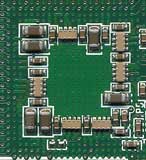 |
ATI insists that the RV250 design is a completely new design and not just a stripped down version of the R200. To a certain extent, this claim may be true, but it is difficult to believe that ATI would start from scratch only to develop a chip that is similar to the R200. In reality, ATI probably ran quite a few simulations and discovered what they could add and remove to keep performance similar to the R200 but decrease cost as much as possible. ATI mentioned to us that they did tinker with their internal caches, but as is the case with most GPUs, information that detailed isn’t publicly available.
One of the more tangible improvements the RV250 holds over the R200 is an upgraded triangle setup engine. In situations that are not texel fetch bound the RV250 can outperform the R200, but in today’s games and even titles like UT2003, this will not generally be the case. You’ll see from the forthcoming synthetic tests that you can drum up scenarios in which the RV250 outperforms the R200, but for the most part, you can consider it to be a lesser performing part.
ATI also outfitted the RV250 core with their FULLSTREAM technology, which is a scaled down version of the pixel shader video technology found in the R300. The ability to run pixel shader programs on video streams is promising, and ATI’s FULLSTREAM technology is one such implementation. With appropriate software support (currently only through RealPlayer), FULLSTREAM can smooth out the blocky compression artifacts that are normally seen in low bandwidth video.
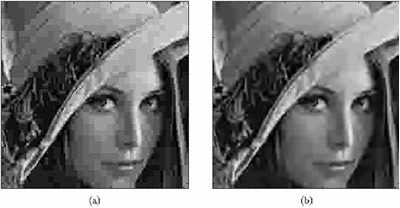
The end result is that the video stream is much less blocky but much more blurry.
The rest of the features and architecture of the RV250 remain unchanged from the R200; there’s still only one vertex pipeline (albeit now paired up with a more powerful triangle setup engine derived from the R300) and the part still offers full DirectX 8 compliance. ATI’s HyperZ II, anisotropic filtering and supersampling AA engines are borrowed, unmodified, from the R200 as well.
If the RV250 was to be a replacement for the R200, then we would be understandably upset about ATI’s design choices, but as you can guess by the title of this article, ATI has something different in mind. The price point of cards based on the RV250 will be similar to the GeForce4 MX 440 and GeForce4 MX 460; compared to the two pipeline/two textures unit per pipe GeForce4 MX architecture, the RV250 is very impressive.
The Cards - Radeon 9000 & Radeon 9000 Pro
When ATI introduced the Radeon 8500 they introduced a very 3dfx-like naming system. The first digit of any model number would dictate what level of DirectX compatibility the card would support; for example, the Radeon 8xxx series would be DirectX 8 cards and the Radeon 7xxx series offer DirectX 7 support.
With the RV250 based cards, the meaning behind ATI’s naming system has been thrown out the door as both DirectX 8 solutions carry the Radeon 9000 label.
The Radeon 9000 and Radeon 9000 Pro are both available immediately from ATI as well as their Taiwanese board partners. The difference between the two cards is simply clock speeds, the Radeon 9000 runs at 250MHz with 200MHz DDR memory (effectively 400MHz); the Radeon 9000 Pro runs at 270MHz with 275MHz DDR memory (effectively 550MHz).
The rest of the features remain identical to the Radeon 8500; both cards support Hydavision, ATI’s multimonitor solution, and they offer the same 3D feature set as the Radeon 8500 as well.
The Radeon 9000 Pro will be priced at $129 with the Radeon 9000 at $109.
As production of the 9000 series boards ramps up, ATI will slowly begin phasing out the Radeon 8500 and 8500LE. Not only can the cards outperform the new 9000 line but they are more expensive to make, so as soon as possible ATI will be phasing out the old 8500 and 8500LE parts.
This unfortunately leaves a major hole in ATI’s product line; the Radeon 9700 (R300) takes care of the high end niche with its $399 price tag, but the next product down from it will be the 9000 Pro. If you want to spend anywhere between $200 and $300 ATI will not have a product for you any longer.
As we mentioned in detail in today’s R300 Preview, the Radeon 9500 will fill this gap in the fourth quarter of this year. Unlike the current 9000 series, the Radeon 9500 will be based on a DirectX 9 architecture – more specifically, a scaled down version of the R300 core (sort of an RV300). We’re expecting this core will only have 4 rendering pipelines and run at lower clock speeds than the R300.
The Test
Obviously the biggest story for today is ATI’s R300, but we did have time to give the Radeon 9000 Pro a run through our benchmarks. Because of the nature of the part we decided to forgo any serious anisotropic filtering or anti-aliasing investigation. If you’re interested in taking a look at the quality or performance hit of either of these features from ATI, we’ve done a number of articles in the past that offer a more in-depth focus on them.
Keep in mind that the Radeon 9000/Pro uses the same anisotropic filtering and AA engines as the Radeon 8500/LE so the quality/performance drop haven’t changed.
| Windows
XP Professional Test Bed |
|
| Hardware
Configuration |
|
| CPU | Intel
Pentium 4 2.4B 133.3MHz x 18.0 |
| Motherboard | ASUS
P4T533-E Intel 850E Chipset |
| RAM | 2
x 128MB PC800 Kingston RIMMs |
| Sound | None |
| Hard Drive | 80GB
Maxtor D740X |
| Video Cards (Drivers) | ATI Radeon 7500
(64MB) - v7.73 |
Unreal Tournament 2003 (DM-Antalus)
We used the same build of Unreal Tournament 2003 as we used in our recent GPU shootout, be sure to read that story for more information on the demo and the levels we benchmarked. As a quick refresher, DM-Antalus is a mostly outdoor level that makes decent use of quadtexturing.
|
At 1024x768 we see that the Radeon 9000 Pro is barely faster thant he GeForce4 MX 460 and significantly slower than both the Radeon 8500 and 8500LE, not to mention that it can't touch the Ti 4200.
|
The Radeon 9000 Pro doesn't really improve as resolution increases, it continues to outperform the GeForce4 MX 460 but it can't hold a candle to the cards that it's replacing.
|
Finally at 1600x1200 the frame rates are honestly too low to be playable and enjoyable, but we see the same trends from before.
Unreal Tournament 2003 (DM-Asbestos)
Our second benchmarking level in UT2003 is DM-Asbestos, which is primarily an indoor level and garners noticeably higher frame rates.
|
Here we actually get to see the Radeon 9000 Pro outperform both the Radeon 8500 and Radeon 8500LE; not to mention that it completely tramples the GeForce4 MX 460.
|
The Radeon 9000 Pro manages to offer performance very close to the Matrox Parhelia but at a $129 price tag, not too shabby at all. Once again, the GeForce4 MX 460 can't even begin to keep up, and let's not forget that the Radeon 9000 Pro is fully DX8 compliant. Two points for ATI.
|
It looks like it won't be until we get GeForce4 performance under $200 that everyone will be able to run UT2003 at 1600x1200.
Jedi Knight 2
Although it's based on the aging Quake III engine, Jedi Knight 2 provided it with a decent refresh and is an example of the performance requirements of a present-day FPS.
|
At 1024x768 the majority of the cards are CPU bound, which allows the GeForce4 MX 460 to take a 7% lead over the Radeon 9000 Pro.
|
The situation changes considerably at 1280x1024 where CPU bottlenecks begin to fade away for the slower cards and fill-rate/memory bandwidth come into play. Here the Radeon 9000 Pro is still slower than the GeForce4 MX 460 however.
|
At 1600x1200 the standings don't change too much, the Radeon 9000 Pro continues to be outperformed by the MX 460.
Serious Sam 2: The Second Encounter
|
Serious Sam 2 proves to be favorable to the Radeon 9000 Pro as it once again outperforms the GeForce4 MX 460.
|
|
Quake III Arena
A golden oldie, Quake III Arena is slowly being phased out by more up-to-date gaming benchmarks but it still paints an interesting picture.
|
It seems as if Quake III engine games do much better with the GeForce4 MX than they do with the Radeon 9000 as we can see by the above results.
|
The GeForce4 MX continues its lead, this time 15% faster than the Radeon 9000 Pro.
|
Overclocking
One of the benefits of a smaller die with fewer transistors is that the headroom on the RV250 should be greater than what we've seen with the Radeon 8500. In order to put this theory to the test we overclocked our Radeon 9000 Pro board from its stock speeds of 270/275 and ended up with 300/315. The 11% boost in core speed helps a bit but it still prevents the Radeon 9000 Pro from surpassing the GeForce4 Ti 4200, but in terms of doing its job of competing with the GeForce4 MX, an overclocked Radeon 9000 Pro does it all that much better.
Final Words
Although clearly not the most interesting ATI product being released today, the Radeon 9000 Pro does its job quite well. The Radeon 9000 Pro, at $129, is able to outperform the fastest GeForce4 MX in most situations and falls behind it in Quake III based games. The performance hit you do take with the Radeon 9000 Pro is worth it however, with the 9000 Pro you get full DirectX 8 pixel and vertex shader support that the GeForce4 MX cannot offer.
When the Radeon 8500LE was released we knew that NVIDIA was feeling quite threatened in the sub-$200 market, but with the $109 and $129 MSRPs of the Radeon 9000 and Radeon 9000 Pro we see every reason for NVIDIA to be worried for this holiday selling season. The RV250 does a much better job of sacrificing features for price than the NV17 core that drives the GeForce4 MX and it does so in such a way that it can carry a very affordable price tag.
It's a shame that ATI had to wait this long to bring out the RV250 core however, it could have been great competition for the GeForce4 MX from the start. But in order to prevent cannibalizing Radeon 8500 sales, the RV250 had to be held off until the R300 was ready to launch. Luckily for NVIDIA, NV31 is coming around the corner and it should bring positive new meaning to their MX line of GPUs.
An even more appealing venture for the RV250 will be in the mobile market, as the core will be the basis of ATI's next-generation Radeon Mobility chip that's due out soon. Considering how it performs against the desktop GeForce4 MX, ATI can be fairly confident that they won't lose traction in the mobile market anytime soon.

